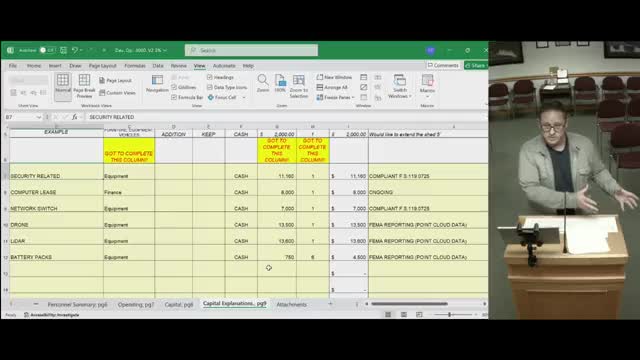County Council Evaluates LIDAR System for Floodplain Management and FEMA Compliance
August 05, 2025 | Baker County, Florida
This article was created by AI summarizing key points discussed. AI makes mistakes, so for full details and context, please refer to the video of the full meeting. Please report any errors so we can fix them. Report an error »

In the heart of Baker County, Florida, the Board of County Commissioners gathered for a pivotal budget workshop on August 5, 2025. The atmosphere buzzed with urgency as officials discussed the integration of advanced technology into the county's infrastructure planning, particularly focusing on the use of LiDAR systems for floodplain mapping and stormwater modeling.
The meeting highlighted the necessity of incorporating LiDAR imagery into the county's Geographic Information System (GIS). This technology, which provides precise elevation data, is crucial for effective disaster response and recovery, especially in light of recent storms that have devastated local communities. One commissioner emphasized the importance of having pre-storm data to accurately assess damage and streamline FEMA reimbursement processes. "We need to be prepared," he stated, reflecting on the harsh realities faced by counties that have suffered from natural disasters.
However, the discussion was not without its challenges. Concerns were raised about the financial implications of the proposed $30,000 investment in the LiDAR system. Commissioners debated the need for a clear operational plan to ensure that the technology would be utilized effectively and not become a costly, underused asset. "We can't just fly it once and forget about it," one commissioner cautioned, stressing the importance of routine data collection to maintain its value.
Training for staff to operate the LiDAR system was also a focal point. While the initial training costs were estimated to be under $2,000, there was a consensus that having multiple trained personnel would mitigate risks associated with relying on a single individual. "We should never have single points of failure," another commissioner remarked, underscoring the need for a robust backup plan.
As the meeting progressed, the commissioners acknowledged the broader benefits of the LiDAR system, including its potential to enhance ecotourism and support search and rescue missions. Yet, the primary focus remained on ensuring that the county could meet FEMA's requirements for disaster preparedness and response.
In conclusion, the workshop served as a critical juncture for Baker County, as officials weighed the benefits of technological advancements against the backdrop of budget constraints and operational readiness. With a commitment to thorough planning and resource allocation, the county aims to harness these tools to better protect its residents and infrastructure in the face of future challenges. The next steps will involve formalizing priorities and ensuring that the necessary staff and resources are in place to make this investment worthwhile.
The meeting highlighted the necessity of incorporating LiDAR imagery into the county's Geographic Information System (GIS). This technology, which provides precise elevation data, is crucial for effective disaster response and recovery, especially in light of recent storms that have devastated local communities. One commissioner emphasized the importance of having pre-storm data to accurately assess damage and streamline FEMA reimbursement processes. "We need to be prepared," he stated, reflecting on the harsh realities faced by counties that have suffered from natural disasters.
However, the discussion was not without its challenges. Concerns were raised about the financial implications of the proposed $30,000 investment in the LiDAR system. Commissioners debated the need for a clear operational plan to ensure that the technology would be utilized effectively and not become a costly, underused asset. "We can't just fly it once and forget about it," one commissioner cautioned, stressing the importance of routine data collection to maintain its value.
Training for staff to operate the LiDAR system was also a focal point. While the initial training costs were estimated to be under $2,000, there was a consensus that having multiple trained personnel would mitigate risks associated with relying on a single individual. "We should never have single points of failure," another commissioner remarked, underscoring the need for a robust backup plan.
As the meeting progressed, the commissioners acknowledged the broader benefits of the LiDAR system, including its potential to enhance ecotourism and support search and rescue missions. Yet, the primary focus remained on ensuring that the county could meet FEMA's requirements for disaster preparedness and response.
In conclusion, the workshop served as a critical juncture for Baker County, as officials weighed the benefits of technological advancements against the backdrop of budget constraints and operational readiness. With a commitment to thorough planning and resource allocation, the county aims to harness these tools to better protect its residents and infrastructure in the face of future challenges. The next steps will involve formalizing priorities and ensuring that the necessary staff and resources are in place to make this investment worthwhile.
View full meeting
This article is based on a recent meeting—watch the full video and explore the complete transcript for deeper insights into the discussion.
View full meeting